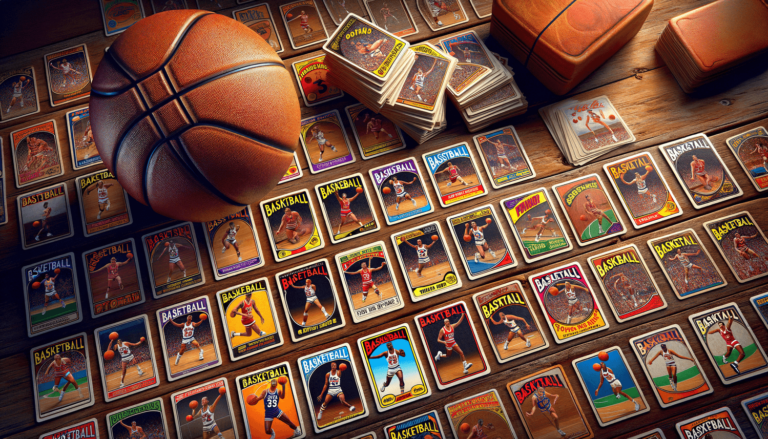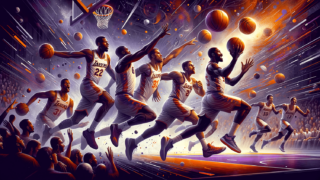
History of Basketball Trading Cards
Written by: Basketball Universe
Last updated:

From their humble beginnings as an advertising gimmick to their transformation into prized collector’s items, basketball trading cards boast a captivating history that many enthusiasts are eager to delve into. Welcome to an exhilarating journey where we unwrap the multicolored layers of basketball trading card evolution, capturing the excitement of basketball legends and the nostalgia of bygone days in one pocket-sized rectangle. Are you ready to discover the tales behind these collectible treasures? Fasten your seatbelts and join us as we explore the fascinating world of basketball trading cards!
History of Basketball Trading Cards
Basketball trading cards originated in the 1940s as card-size advertisements with player photos, which were packaged with gum or candy to entice customers. Over time, they evolved into collectible items, with significant milestones like the 1948 Bowman set and the 1961 Fleer set, featuring many key rookie cards. The 1980s and 1990s marked the trading card boom, as companies diversified designs and introduced special editions, autographs, and memorabilia cards. Despite market fluctuations, basketball trading cards remain popular today, most notably with the rise of e-commerce, and continue to capture the passion of collectors and fans alike.
The Birth of Basketball Trading Cards
In the early days of basketball history, trading cards were mere gimmicks to attract customers to buy gum or candy products. It was in 1948 when George Mikan was featured in the illustrious Bowman set that basketball trading cards truly began taking shape as collectible items. The primary focus for these cards was to showcase admired athletes and their accomplishments, sparking interest and fostering a growing community of collectors.
Rise of the Rookie Cards
Perhaps one of the most landmark moments in the history of basketball trading cards came in 1961 with the release of the Fleer set, which introduced the concept of rookie cards. These cards quickly gained popularity as they featured the debuts of some of the sport’s greatest legends, such as Wilt Chamberlain, Oscar Robertson, and Jerry West. Rookie cards soon became highly sought-after items and a driving force for collectors to acquire, trade, and invest in.
Key Rookie Cards
Over the years, several rookie cards have stood out for their significance in basketball history and their value in the collecting market. Some of the most notable ones include:
- Lew Alcindor (1970 Topps)
- Larry Bird and Magic Johnson (1980 Topps) – A unique card featuring both players on one panel, increasing its demand and value.
- Michael Jordan (1986 Fleer) – Perhaps the most iconic basketball trading card and the crown jewel of many collectors.
- Shaquille O’Neal (1992-93 Upper Deck) – Known for its striking, gold-foil rookie logo.
- LeBron James (2003-04 Topps Chrome) – Reflective of the modern era’s flagship set, with a highly coveted refractor parallel.
Diversification and Innovation
The 1980s and 1990s saw a trading card boom that spurred companies to differentiate themselves by creating a vast array of designs, subsets, and features. Many brands like Skybox, Upper Deck, and Topps emerged and linked their innovations to technological advancements and creative marketing strategies, bidding for a share of the ever-increasing basketball fanbase.
Special Editions
Trading card companies recognized the potential for limited edition cards with varying rarity and distinct designs, spawning a frenzy among collectors to acquire these exclusive pieces. Sets such as the Skybox Metal Universe, the Topps Finest, and the Upper Deck SPX, introduced chromium, acetate, and hologram cards, generating unprecedented excitement for fans and collectors alike.
Autographs and Memorabilia
Basketball trading cards began to feature signatures, game-used gear, and other memorabilia, amplifying their allure by connecting fans more intimately with their favorite players. Companies like Upper Deck spearheaded what would become a staple in modern sports card collecting by rolling out their first autographed insert cards in 1991, starting with the Michael Jordan autographed card in the NBA All-Star set.
Serial Numbering
Serial numbering elevated the basketball trading cards market through increased rarity and value. Cards featuring limited print runs provided collectors with a tangible representation of their exclusivity, igniting competition to acquire the most special and limited cards. The 1993 Topps Finest Refractors, for example, featured a refractor parallel with serial numbers limited to just 199 copies.
Navigating the Market Fluctuations
Collecting basketball trading cards has experienced its fair share of ups and downs over the years. Market fluctuations have forced enthusiasts to adapt to the changing landscape, balancing between the love for collectibles and mindful investment.
The Overproduction Era
The rapid expansion during the late 1980s and early 1990s prompted many manufacturers to ramp up their production to meet demand, resulting in a flooded market. This overproduction led to diminishing values for once-beloved cards, making it challenging for collectors to know which cards were truly rare and valuable.
Exponential Growth
Despite market fluctuations, interest in basketball trading cards has soared in recent years. Factors such as nostalgia, renewed enthusiasm for the sport, and record-breaking performances have driven demand for older and newer cards alike. Prices for iconics cards, like Michael Jordan’s 1986 Fleer or LeBron James’ 2003 Topps Chrome, have exploded in value, making them the centerpieces of many basketball collections.
Online Revolution and Modern Collecting
In today’s age of e-commerce, collecting basketball trading cards has taken on a new dimension. Platforms like eBay, Beckett Online Marketplace, and ComC have enabled buyers, sellers, and traders from around the globe to connect and participate in the card market. Streaming platforms also facilitate group breaks where collectors acquire shares of a box or case, collectively experiencing the excitement of opening packs and revealing the cherished cards within.
Grading Services
Professional grading services, such as PSA, Beckett, and SGC, have played a significant role in transforming the modern basketball trading card market. By evaluating the condition of the card, grading companies provide an independent assessment that bolsters the value and trustworthiness of a card. This third-party confirmation allows collectors to invest confidently in their purchases and add credibility to their collections.
Innovations in Trading Cards
Modern technology continues to revolutionize the basketball trading card industry. Crypto-based NFT technology has entered the world of sports collectibles, creating new opportunities for fans to dive into digital collecting. Cards with added features like video clips or interactive aspects supplement the experience of today’s collectors.
Finding Your Basketball Trading Cards Niche
With the vast array of options available in the basketball trading card world, many collectors choose to specialize in a particular niche, crafting their collecting journey to align with their passions and interests.
Focusing on Players
Some collectors might opt to focus on a specific player, amassing a range of cards that reflect that athlete’s career, from rookie cards to special edition inserts. Whether it’s their childhood hero or a promising rookie, these collectors relish in showcasing the achievements and progress of their favorite player.
Team Collections
Collecting the cards of an entire team can be a rewarding pursuit for fans who live and breathe their team’s ups and downs. From legendary franchises like the Boston Celtics and the Los Angeles Lakers to newer additions like the Miami Heat, Oklahoma City Thunder, or the Toronto Raptors, team collectors can rejoice in the growth and evolution of their beloved squad.
Set Building
Set builders comprise those who gravitate toward completing specific card sets. Be it the base set, parallel sets, or subsets with exclusive features, set builders dedicate themselves to hunting down every card required to build the perfect compilation. In some instances, these individuals might choose to focus on a particular era or brand for an added challenge.
From their inception as advertisements to the booming market they’ve become today, basketball trading cards continue to captivate the hearts and minds of enthusiasts worldwide. Their rich history serves as a time capsule of unforgettable moments and treasured memories, ensuring that the love for these collectibles lives on for years to come.
Marketplace Tips for Collectors
As collectors dive into the world of basketball trading cards, they might find the marketplace a bit overwhelming or even intimidating. It’s essential to understand some tips and strategies to navigate this vast world and enhance the collecting journey. Below are a few key points to guide you through the process.
Research is Your Friend
Ensure you take time to research cards, their market value, and trends to make educated decisions when building your collection. Leverage websites like eBay’s sold listings, Beckett’s price guide, and Card Ladder to track cards’ prices and stay up-to-date with market fluctuations. With a good understanding of the market, you’ll be better positioned to identify fair deals and steer clear of overpriced cards.
Buying, Selling, and Trading Online
Following best practices in buying, selling, and trading basketball cards online can help you avoid potential pitfalls. When purchasing cards online, check the seller’s feedback score, and examine card images carefully to spot possible transparent issues. When listing your cards, be honest about the condition, and provide clear photos to disclose any flaws. Finally, establish secure communication channels with potential trading partners, only using trusted platforms for finalizing trading deals.
Attend Card Shows and Events
Basketball card shows and events present excellent opportunities to network, learn, and discover cards for your collection. At these events, you can talk to fellow collectors, buy or trade cards, and even interact with professional athletes. By attending local and national conventions like the National Sports Collectors Convention, you can expand your knowledge, develop connections in the hobby, and discover cards you might not have found elsewhere.
Taking Care of Your Collection
Once you’ve started building your basketball trading card collection, it’s vital to ensure proper care and storage. Implementing appropriate measures not only maintains the cards’ aesthetic appeal but also preserves their value over time.
Best Practices for Card Handling
Always handle cards with care by using clean hands and avoiding direct contact with the card’s surface as much as possible. Fingertips are a source of natural oils and acids, which can potentially damage cards over time. Touch only the edges or use card sleeves or top-loaders as a protective barrier for your cards.
Storage Solutions
Invest in quality storage solutions, as sub-par storage materials can negatively impact the longevity of your cards. Some of the most popular and recommended options are:
- Binder and/or plastic sheets – Ideal for organizing sets and easy viewing, binders provide an excellent solution for lower-value cards.
- Top-loaders – Clear, rigid plastic holders that protect individual cards for higher-value items.
- One-touch magnet cases – These cardholders offer an added level of protection for your most valuable and coveted cards.
Environmental Considerations
Keep in mind that the environment where you store your collection also plays a crucial role in preserving it. Maintain a stable temperature and control humidity to prevent warping, cracking, or fading. It’s also advisable to minimize your cards’ exposure to direct sunlight or UV light, as they can cause the colors to fade over time.
By keeping these tips and guidelines in mind, you can foster a rewarding experience in the world of basketball trading cards. Building, organizing, and preserving a cherished collection not only reaffirms your love for the sport but also serves as a testament to the fascinating history encapsulated within these treasured pieces of cardstock.
FAQ Section: Basketball Trading Cards
If you’re new to the world of basketball trading cards or looking for quick answers to your burning questions, take a look at this FAQ section. We’ve rounded up some of the most common queries related to this fascinating hobby, making it easier for you to dive right in!
What is the most expensive basketball trading card?
The 2009-10 National Treasures Logoman Autographs set featuring a rookie Stephen Curry is considered among the most expensive basketball trading cards, with one card fetching over $5.9 million. Prices of cards like these may vary, depending on factors such as condition, rarity, and graded value.
Where can I buy basketball trading cards?
You can purchase basketball trading cards through various channels such as local hobby shops, card shows and events, retail stores, and online platforms like eBay and ComC. For newer cards, you can also buy packs, boxes, or cases directly from card manufacturers or authorized distributors.
What is the primary difference between base and parallel cards?
Base cards are the standard cards found in a particular set, whereas parallel cards are a variation of the base cards that feature unique design elements or characteristics. Parallels might differ in color, finish, serial numbering or added features, and are often rarer and more valuable than base cards.
How can I determine the value of my cards?
To determine the value of your cards, start by researching their market prices through price guides like Beckett, online marketplaces such as eBay, and tracking tools like Card Ladder. Condition, rarity, and market trends also play a crucial role in determining a card’s value.
Why should I get my cards graded?
Grading your cards through reputable companies like PSA, Beckett, or SGC can enhance their value and marketability. Grading provides an independent assessment of the condition of the card, which helps assure potential buyers of its authenticity and condition.
How do I protect my basketball trading cards?
To protect your basketball trading cards, store them in high-quality materials like binder plastic sheets, top-loaders or one-touch magnet cases. Avoid exposure to direct sunlight, maintain a stable temperature, and control humidity to prevent warping, cracking or fading of your cards.
What are autographed basketball trading cards?
Autographed basketball trading cards are cards that feature a player’s authentic signature, which may be hand-signed or machine-stamped. These cards usually hold a higher value because they offer a unique and personal connection between fans and their favorite athletes.
Are older basketball trading cards always more valuable?
Not necessarily. The value of a basketball trading card depends on variables such as player popularity, card rarity, condition, and the set it belongs to. Although older cards tend to generate nostalgic appeal, they are not always more valuable than newer cards featuring current stars or rare designs.
What are group breaks?
Group breaks are a popular method of opening packs and boxes of sports cards collectively. Several collectors pool their resources to buy shares of a box or case, and the cards are then distributed among the participants according to pre-determined rules such as team or player allocation.
What is NFT technology for basketball trading cards?
NFT (Non-Fungible Token) technology has recently entered the realm of sports collectibles, providing digital alternatives for physical cards. These unique, blockchain-based digital assets can include features like distinctive designs, video clips, or interactive elements, offering a new experience for collectors.
Featured Posts
- No pillar pages found.





